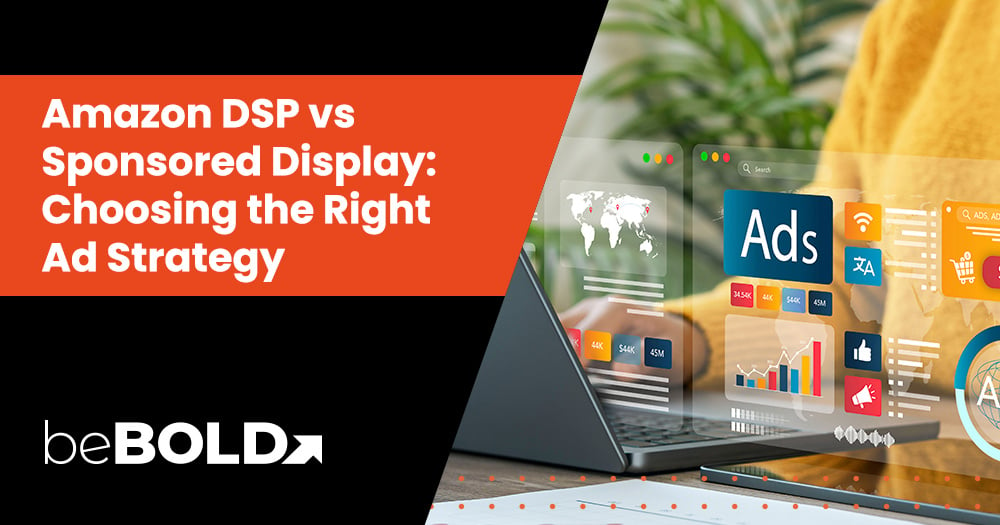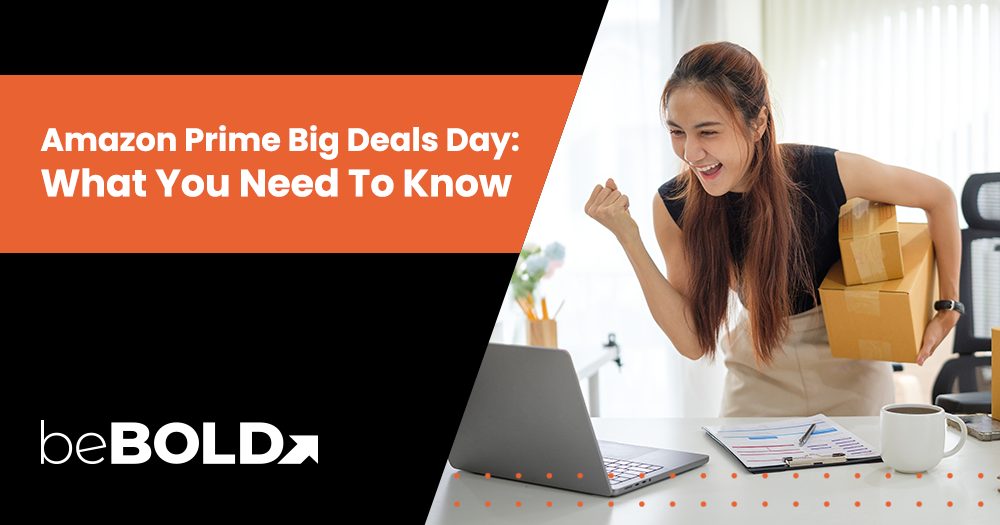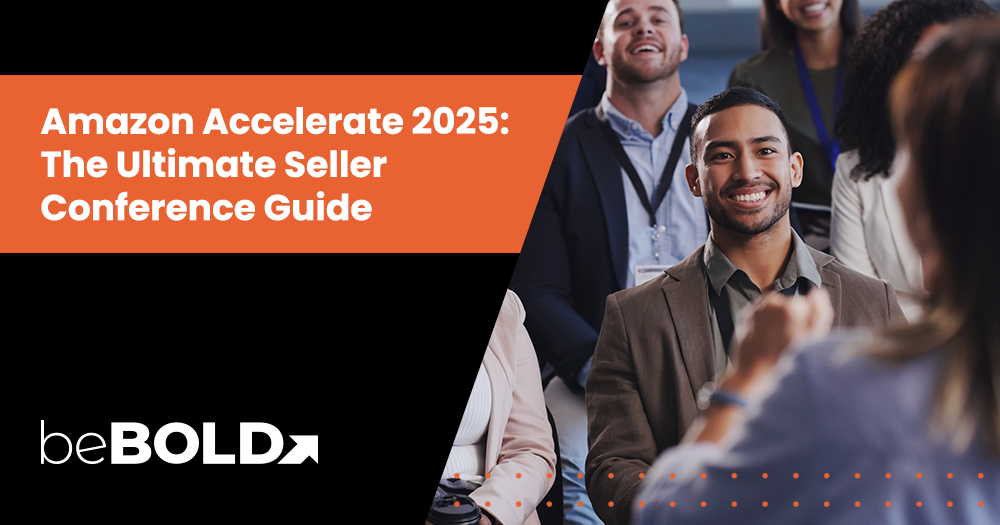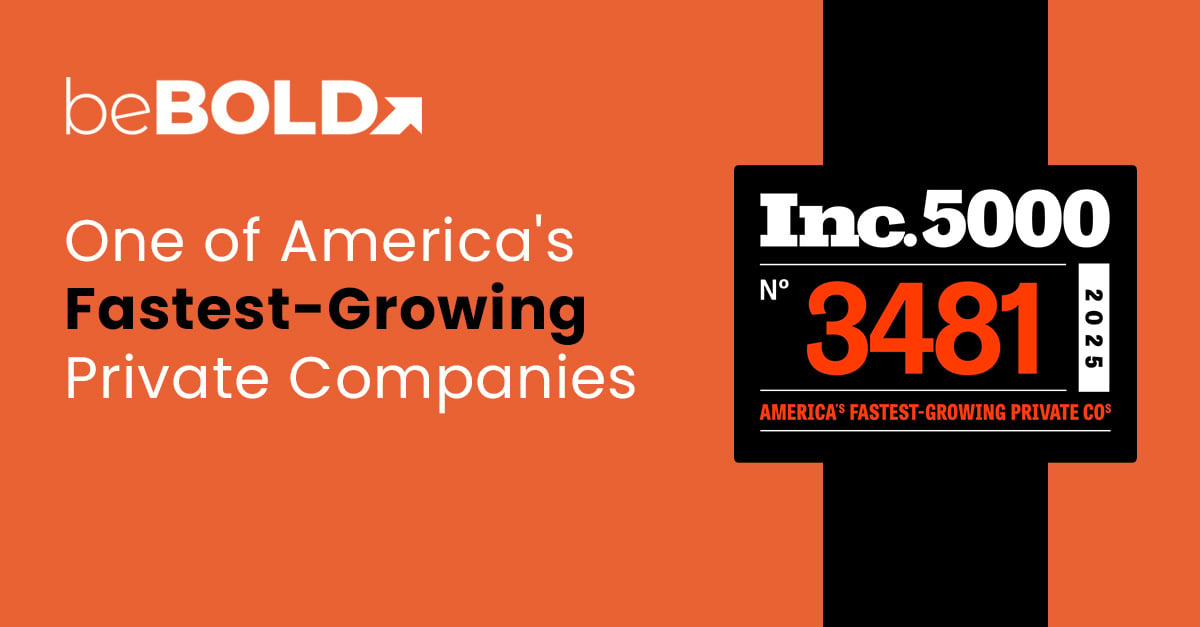Key Takeaways
- Amazon DSP offers broader reach beyond Amazon, advanced audience targeting, and custom creatives—ideal for brands focused on awareness and with larger budgets 📈.
- Sponsored Display is easier to launch, cost-effective, and great for retargeting on and off Amazon—best for driving sales within the marketplace 🛒.
- DSP uses a CPM model (cost per 1,000 impressions) with a high minimum spend 💰, while Sponsored Display runs on a PPC model with no major spend requirement.
- DSP provides greater creative flexibility and detailed control 🎨, whereas Sponsored Display is more automated and accessible for all advertisers.
- Brands with limited experience or budgets may benefit more from starting with Sponsored Display, while DSP suits data-driven, large-scale campaigns 🧠.
- Many brands benefit from a hybrid approach, using both DSP and Sponsored Display to balance awareness and conversions ⚖️.
- Choosing the right strategy depends on your goals, expertise, and available resources, and partnering with an expert like beBOLD Digital can help maximize results 🚀.
When scaling your brand on Amazon, how do you decide between Amazon DSP vs Sponsored Display Ads? Choosing the right ad strategy can feel overwhelming, especially when both options promise to expand your reach and drive sales.
Advertisers often struggle with understanding where their budget will have the most impact. Should we invest in DSP’s programmatic buying for broader audience targeting or use Sponsored Display’s simplicity for quick, self-service campaigns? Each has strengths, but the wrong choice could lead to wasted ad spend and missed opportunities. This blog breaks down the key features, pros and cons to help you make an informed decision that aligns with your brand’s goals.
What is Amazon DSP?

Amazon DSP, standing for Demand-Side Platform, is an online advertising approach offered by Amazon. It allows advertisers to buy and manage video, display, and audio ads programmatically, not only on Amazon.com but also on various other Amazon-owned sites and apps.
Whether an Amazon FBA seller or a business not selling directly on the platform, you can leverage DSP to reach underexploited audiences, boost brand awareness, and significantly increase your brand’s visibility.
Key Features of Amazon DSP
Amazon DSP offers advanced advertising solutions that help brands reach highly targeted audiences beyond Amazon’s marketplace. Here are its key features:
Amazon DSP offers advanced targeting, broad reach, and flexible campaign management. Here are its key features:
- Data-driven targeting: Amazon’s first-party data targets shoppers based on purchase history, browsing behavior, and intent signals, ensuring ads reach high-converting audiences.
- Access to rich inventory: Provides ad placements on Amazon-owned platforms like Fire TV, Kindle, and Amazon Live, as well as third-party exchanges and publishing partners, expanding reach beyond Amazon’s marketplace.
- Custom campaigns: Enables brands to tailor messaging, creative assets, and targeting strategies to specific goals, optimizing ad spend for better engagement and conversions.
Pros & Cons of Amazon DSP
While Amazon DSP offers many benefits for brands, it also comes with a few constraints that one must consider when utilizing Amazon’s DSP.
|
Pros |
Cons |
|
Vast Reach: DSP ads can reach beyond Amazon.com to other Amazon-owned sites and apps, and several third-party platforms. |
Technical Complexity: Amazon DSP has a steep learning curve. Therefore, businesses new to online advertising might find it complicated at the outset. |
|
Detailed Reporting: Advertisers get detailed reports on campaign performance and user engagement, helping them analyze and enhance their ad strategy. |
Higher Investment: The minimum monthly spend for DSP is around $10,000 - $35,000, which might seem steep for smaller brands. |
|
Advanced Audience Targeting: Amazon DSP lets businesses target specific audiences based on comprehensive user data. |
Lack of Accessibility: DSP is not available in the Advertising Console, making it necessary to manage it from a separate DSP console. |
|
Creative Control: Customization of basic creative elements like headline, brand logo, and image increases ad attractiveness. |
Support for Products with Minimal Traffic: DSP campaigns for products with negligible traffic might be hard to run efficiently. |
What are Amazon Sponsored Display Ads?

Traditional sponsored ads often limit advertisers to placements within Amazon’s marketplace, making it difficult to re-engage potential buyers who leave without purchasing. Amazon Sponsored Display Ads solves this by combining display and product advertising, offering an advanced retargeting solution that brings shoppers back to your listings.
Unlike standard ads, these can appear not only on Amazon.com but also across external websites, apps, and other devices. This extended reach helps brands stay visible, reinforce messaging, and capture lost sales opportunities.
Key features of Sponsored Display
Many advertisers struggle with complex ad setups, limited targeting, and rigid budgets restricting campaign performance. Sponsored Display simplifies the process while offering flexibility and control.
- Simple setup: Unlike Amazon DSP, which requires a managed-service approach, Sponsored Display is a self-service ad type that is easy to launch without advanced programmatic expertise. This makes it accessible for businesses of all sizes.
- Targeting options: Offers automated audience targeting based on shopping behavior, interests, and past product views, helping brands retarget potential customers and reach new audiences more effectively.
- Budget flexibility: Allows advertisers to start with lower budgets and adjust spending as needed, making it a cost-effective solution for both small and large brands looking to scale their ad efforts.
Pros & Cons of Sponsored Display Ads
Like DSP, Amazon Sponsored Display Ads offer various advantages but also carry a few drawbacks that advertisers must consider:
|
Pros |
Cons |
|
Accessibility: Sponsored Display ads extend beyond Amazon's marketplaces, offering a wider reach. |
Limited Audience Selection options restrict the depth of achievable audience targeting. |
|
Simplified Management: With access to the Advertising Console, the setup and management of ad campaigns are pretty simple. |
No Option to Exclude Certain Audiences, confining the control over ad reach. |
|
Flexible Spending: These ads are suitable for businesses of all sizes as there's no requirement for a substantial minimum spend. |
Limited Creative Options: Despite some recently introduced customizations, the creative control is still limited compared to DSP. |
|
Traffic Retention: Sponsored Display ads' retargeting feature helps keep potential customers engaged. |
Lower Placement Priority: Sponsored Display ads compete with other ad types, that is, they may not always get the best placements, especially when bidding against higher-budget campaigns. |
Want to know if Amazon sponsored ads are worth it in 2025? Check out our guide to explore the benefits and make a confident decision.
Amazon DSP vs Sponsored Display: Key Differences
Amazon DSP and Sponsored Display have key differences that impact cost, targeting, creative control, and campaign management. Let's understand the key difference of Amazon DSP vs Sponsored Display:
Brand Eligibility
Amazon DSP is ideal for brands not selling on Amazon, offering access to its vast audience beyond the platform. In contrast, one of the biggest differences is that Sponsored Display ads are tailored for businesses looking to boost sales and brand awareness, specifically within Amazon’s marketplace. While DSP allows for broader targeting, Sponsored Display focuses on in-marketplace users.
Cost Variance
Cost structure varies significantly between the two ad types. Amazon DSP follows a Cost Per Mille (CPM) cost structure, where you pay the average price for 1,000 impressions of your ads. It’s primarily aimed at reaching a broad audience base for building brand awareness.
On the other hand, Sponsored Display adopts a Pay Per Click (PPC) model, which calculates the average cost you pay each time someone clicks on your ads. The PPC model is more conversion-focused, aiming to drive traffic back to your Amazon listings. Depending on your goal, conversions vs. brand awareness, one cost structure may be preferable over the other.
Minimum Investment
When it comes to minimum investment, Amazon DSP requires a heftier upfront commitment than Sponsored Display ads. For DSP, the self-service advertising solution demands a minimum monthly advertising budget of about $10,000, while the Amazon Managed Services DSP requires a bulkier minimum of around $35,000 monthly.
On the contrary, there's no significant barrier to entry with Sponsored Display ads, as all brands can get started with a nominal minimum spend of just $1. This stark investment contrast makes Sponsored Display a more accessible initial step for small-scale and growing businesses.
Creative Control
In terms of creative control, Amazon DSP ads lend substantial flexibility to advertisers. With DSP, you can fully customize your ads – the headline, brand logo, and even custom-design the ad image. Their Dynamic eCommerce Ads (DEA) are also in beta, potentially including eCommerce features like retail price and review ratings display for up to 20 ASINs.
On the flip side, Sponsored Display ads keep things simple. These ads automatically generate display ad creatives optimized to deliver results on the product detail page, offering a limited scope for personalization. However, the automation makes it a lower-maintenance option for brands without the resources or time to manage ad creatives manually.
Targeting Custom Audience
Amazon DSP and Sponsored Display differ significantly in their ability to target custom audiences. While the latter offers three basic targeting options like product targeting, views remarketing, and audience interests, DSP goes an extra mile by providing valuable audience insights.
Amazon DSP allows businesses to build custom segments using demographic and user activity data collected from Amazon. You could even create custom audiences using your customers' information, allowing you to construct specialized, highly targeted segments for your ads. DSP provides more control if granular targeting is critical to your ad strategy.
Brand Protection
Brand safety is crucial in online advertising. Amazon DSP provides control over where ads appear, ensuring your brand is protected from inappropriate environments. While it automates ad placements, it focuses on safeguarding your brand’s image and maintaining high traffic quality. This allows businesses to reach a broad audience without compromising their reputation. By offering transparency and control, DSP enables brands to maintain trust with their customers.
Learning Curve
Sponsored Display is easier to set up and manage through the Amazon Advertising Console, making it ideal for brands new to advertising. In contrast, Amazon DSP is more complex and requires technical expertise and a deeper understanding of Amazon’s ad ecosystem. The choice between DSP and Sponsored Display often depends on your business’s level of expertise and available resources.
Ad Inventory
Both Amazon DSP and Sponsored Display ads offer extensive ad inventories for display advertising to attract and engage with potential customers. DSP gives you control over a broader range of ad inventory through different ad types like video, display, and audio across multiple platforms.
On the other hand, Sponsored Display focuses on producing automated creatives optimized for delivering results. They can appear on various placements on and off Amazon, boosting your chances of reaching a diverse audience.
Campaign Complexity
The complexity of setting up and managing ad campaigns under Amazon DSP is considerably higher than that of Sponsored Display. Amazon DSP demands a deeper understanding of programmatic buying, demographic data analysis, creating custom ads, etc.
On the other hand, using Sponsored Display is more straightforward since it primarily functions on automated retargeting principles. You must set your budget, pick your products, and let Amazon handle the rest.
Want to see effective Amazon ad examples for every type and format? Check out our detailed guide to understand how they work and which ones suit your brand best.
Amazon DSP vs Sponsored Display: How to Determine the Best Ad Strategy for Your Brand
.png?width=431&height=806&name=Ad%20placement%20example%2c%20product%20detail%20page%20(Custom%20image%2c%20Video).png)
Identifying the right ad marketing strategy between Amazon DSP vs Sponsored Display depends on multiple factors, including your business goals, available resources, and level of expertise. Both platforms offer unique strengths and cater to distinct requirements.
Consider Your Business Goals
Your advertising strategy should align with your business goals. Are you focused on building brand awareness, or is driving traffic and conversions your priority? If expanding your reach and attracting new customers while boosting brand exposure are key, Amazon DSP’s wide coverage is a great choice. However, if your main goal is to increase conversions and sales on Amazon, Sponsored Display ads offer a more targeted approach.
Assess Your Budget and Resources
The intensity of your resources and budget capacity can significantly influence the choice between Amazon DSP and Sponsored Display. Amazon DSP requires a more considerable initial financial commitment and sophisticated management due to its complexity. Thus, DSP could be a strategic fit if your business owns substantial resources and budget bandwidth.
Comparatively, Sponsored Display narrows the initial financial commitment and requires simpler resources for smooth operation. So, Sponsored Display is a worthy choice for businesses trying to capitalize on advertising without significant upfront investment.
Factor in Your Level of Expertise
How adept is your team in leveraging and managing online advertisements? Gauging your level of expertise is vital before choosing between the two ad strategies. Amazon DSP with its programmatic nature demands a higher degree of expertise to be efficiently utilized. It's a data-centric platform that requires a detailed understanding of Amazon's ad ecosystem.
Meanwhile, a Sponsored Display campaign, with its easy setup, accessibility, low cost, and effortless manageability, is a better fit for advertisers stepping into Amazon advertising. So, consider your comfort level with Amazon's ad landscape before deciding your ad path.
How beBOLD Digital can help you succeed with Amazon DSP and Sponsored Display
Struggling to choose between Amazon Sponsored Display vs DSP? Finding the right advertising strategy can be overwhelming, but beBOLD Digital simplifies the process. Our expert team provides both services, ensuring your brand maximizes reach, engagement, and conversions.
beBOLD Digital is a full-service Amazon agency helping brands grow and excel in the digital marketplace. Our team of experienced e-commerce professionals brings a deep understanding of the complexities of the Amazon platform and leverages their expertise to drive success in sales. We provide tailored strategies that align with your goals, balancing performance and profitability.
With a comprehensive suite of capabilities such as account management, catalog management, SEO and A+ Content, PPC, and DSP ad management, we can provide you with strategies tailored to your unique goals.
Book a call to grow your brand on Amazon and Walmart!
Final Thought
Amazon DSP and Sponsored Display are potent tools, but the right choice depends on your goals. DSP is ideal for brands looking to expand beyond Amazon with advanced audience targeting, while Sponsored Display is a simpler way to drive traffic and conversions within Amazon’s ecosystem. Many brands benefit from both, creating a balanced approach to reach and sales. Understanding your needs and resources will help determine the best strategy for growth.
Frequently Asked Questions
Is Sponsored Display the same as DSP?
No, Sponsored Display and DSP ads are different. While both types promote brand visibility and product advertising, their eligibility criteria, cost structures, level of creative control, custom audience targeting capabilities, campaign complexity and minimum investment requirement differ.
What does it mean when you see sponsored on Amazon?
When you see 'sponsored' on Amazon, the listing is a paid advertisement. Advertisers use such sponsored placements to increase their product's visibility and boost sales. It doesn't affect the product quality or reliability in any way.
When to use Amazon DSP?
Consider using Amazon DSP when the aim is to increase your brand awareness on a larger scale. It is particularly beneficial for brands not selling directly on Amazon and those seeking comprehensive reach, deeper targeting options, creative flexibility, and robust audience analysis.
When to use Sponsored Display?
Use Sponsored Display ads when the objective is to drive traffic to your Amazon store listings, thereby improving sales and brand recognition on Amazon's marketplace. They are ideal for businesses seeking cost-effective, easy-to-set-up, automated retargeting solutions.
Is a sponsored post-paid?
Yes, a sponsored post is a type of advertisement, the advertiser pays. The aim is to increase reach, enhance brand awareness, or promote specific products or services. Such paid ads are distinctly labeled as 'sponsored' for transparency with potential customers.
Book a call today and take the next step towards better performance and higher sales.









Comments